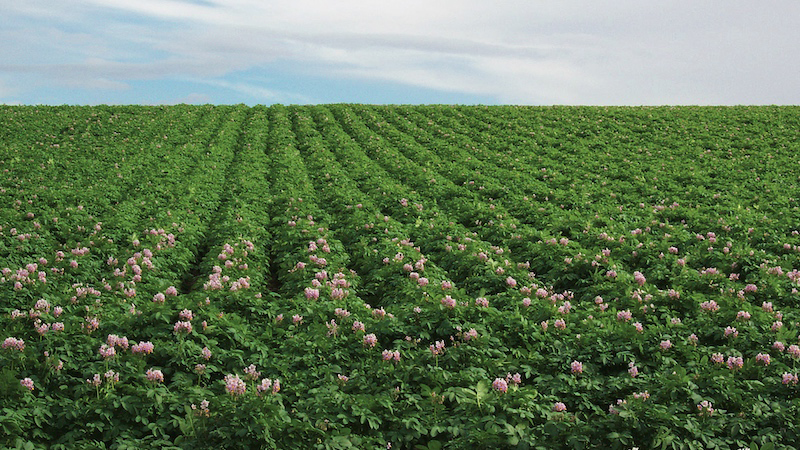Which Beneficial Wasp Species Works Best Against Fruitworm in Blueberries?

Up close and personal with the Trichogramma platneri.
Photo by Carlos Garcia-Salazar
Carlos Garcia-Salazar is no stranger to the Trichogramma genus and its benefits as a biological control. The veteran Extension Specialist, a mainstay at Michigan State University since 1999, has documented the efficacy of several such wasps and their egg parasitoids against orchard-damaging moths and caterpillars.
“When I came here to Michigan State, I used to work on biological control of apples — against codling moth — and pecan trees, so I know a lot about Trichogramma,” says Garcia-Salazar, who presented on the topic at the Great Lakes Fruit and Vegetable Expo in December.
His focus these days is on Michigan’s blueberry industry and the available treatment options against cherry fruitworm (CFW) and cranberry fruitworm (CBFW). The state is the second-largest blueberry producer in the U.S., with more than 500 farms accounting for approximately 21,700 acres of the crop.
WHICH SPECIES WORKS BEST?
In Michigan the prevalent natural biological control agent against the fruit fruitworm complex has been T. minutum. Egg parasitism has ranged from 10% to 17% in unsprayed fields and 7% to 8% in fields under reduced-risk integrated pest management. In addition, Ichneumonid wasps, mainly Campoletis patsuiketorum, have parasitized 28% of larvae.
“These are our friends that we find in the field,” Garcia-Salazar says.
But are they the best friend a Michigan blueberry grower can find? Different species and strains of Trichogramma typically can prefer differing host eggs, crop habitats, host-searching behaviors, and tolerances to weather conditions. With CBFW, for example, T. pretiosum has been found to attack host eggs mainly in low-growing crops, such as cranberries. Meanwhile, T. minutum has been found to attack egg hosts in bushes and tree fruit crops, such as blueberries and apples.
Garcia-Salazar established a trial in 2022 to determine the best species for Michigan blueberry fields. Unfortunately, the closest reliable source of commercially produced T. minutum was in California. A second option, T. pretiosum, was ruled out based on discouraging data from an earlier trial involving cranberries.
Next in line was T. platneri, which is essentially the same species as T. minutum with one distinction: “Trichogramma minutum is the name of the species on the West Coast,” Garcia-Salazar says. “Here we have Trichogramma platneri. The separation is geographic location. DNA analysis shows no difference.”
Based on that determination, and until further notice, “what we have here in Michigan,” Garcia-Salazar says, “is T. platneri.”
Either way, the species appear to be good things.
ALL ABOUT TIMING
Garcia-Salazar proceeded with his trial at two sites. Veronica Cervantes, an IPM Specialist/Technical Advisor with Michigan-based Biobest USA (now recognized as Plant Products Inc.) provided the T. platneri under the brand name TRICHOforce PL.
At Nye Farm, in Ganges, MI, T. platneri — released twice at a rate of 100,000 per acre — was compared with control (no insecticide and non-Trichogramma). At Coleman Farm in Glenn, MI, the same T. platneri treatment was compared with the same control as well as a conventional application of Imidan (phosmet).
The results at Nye Farm were “not what we wanted,” Garcia-Salazar says. With CFW, samples of the non-Trichogramma group showed 90 damaged fruit clusters compared with 101 in the Trichogramma group. With CBFW, the results were better — 37 to 14 in favor of the
T. platneri group — but not significant.
“The reason for this was because the Nye Farm is located 3 miles from Lake Michigan and is in a hilly area, so it was warmer,” Garcia-Salazar says. “The emergence of overwintering fruitworm populations occurs one week earlier than at the Coleman Farm, which is located a quarter mile from Lake Michigan. Timing is critical.”
As expected, the outcome at Coleman Farm was better — comparable to Imidan, most importantly — although still not statistically significant, according to Garcia-Salazar. With CFW, damaged fruit clusters numbered zero for Imidan, five for Trichogramma, and 38 for non-Trichogramma. With CBFW, the numbers were zero for Imidan, three for Trichogramma, and 17 for non-Trichogramma.
“We are still working on the analysis and making sure we can present this valuable information, but it is very encouraging that we can actually control cranberry and cherry fruitworm if we release the insects in time,” Garcia-Salazar says.
A series of experiments in 2023 will include the addition of Bacillus thuringiensis to control newly hatched fruitworm larvae from non-parasitized eggs, and entomopathogenic nematodes to manage the spotted wing drosophila.
“Because once you add one more mortality factor, you increase your chances of controlling the pest,” he says.










